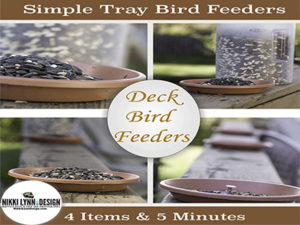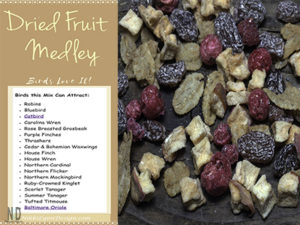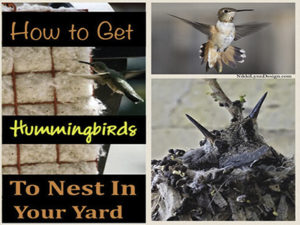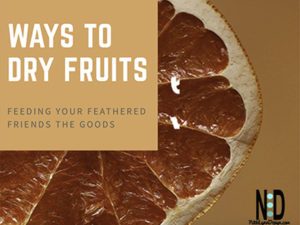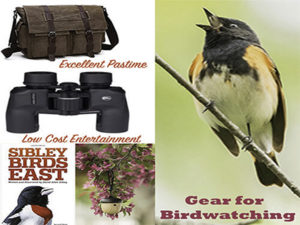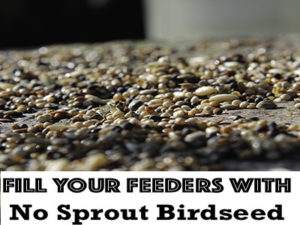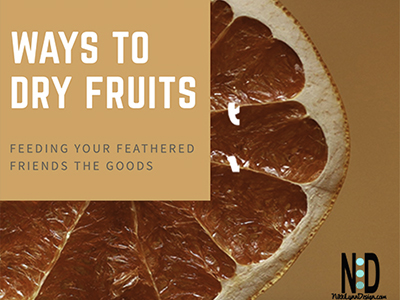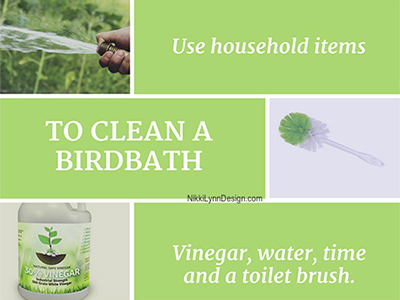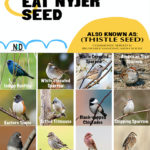Birds That Eat Nyjer Thistle Seed
Below are some common birds that eat Nyjer thistle seed at your feeders. The listing will include pictures and identifying markings to help you ID the birds that will be attracted to the seed.
If you want to attract a certain bird, you need to know what the bird enjoys eating. This article will guide you through the common birds that eat thistle seeds.
What is Nyjer Thistle Seed?
Nyjer seed is a high oil thistle seed that attracts a variety of finches and small songbirds with small beaks. The seed costs more but is waste-free, leaving no mess or grow under feeders.
This tiny delicacy is used in finch feeders which have smaller holes and tiny perches.
Perfect for small birds but discouraging to larger birds. High fat and protein content.
No waste, no mess, no growth under feeders.
BUY ON AMAZON
Feeders To Use Nyjer Thistle Seed In
CAPACITY: Tube birdfeeder holds up to 3-1/2 pounds of birdseed; 20 feeding ports.
EFFICIENCY: Internal baffle ensures feeder empties completely without seed buildup.
CONVENIENCE: Slide the cap up the hanger for quick filling.
DURABILITY: Die-cast metal base and cap; UV-stabilized polycarbonate tube.
BUY ON AMAZON
Seed Socks
3 Nyjer Sack bird feeders
For feeding thistle seeds to wild birds.
Heavy-duty nylon mesh specially designed for year-round feeding
BUY ON AMAZON
Birds That Eat Thistle Seed
1.) Indigo Bunting
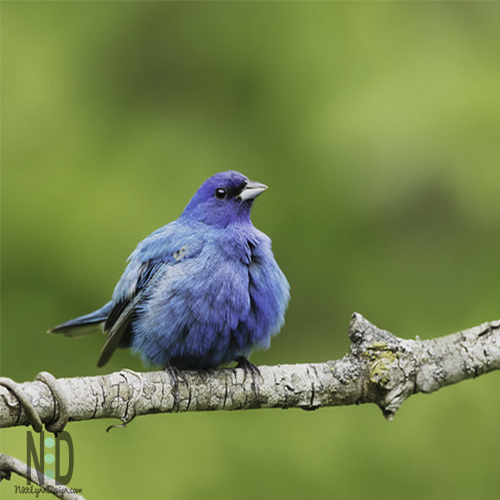
Indigo Bunting is a bird in the cardinal family.
The male is a vibrant blue in the summer and a brown color during the winter months, while the female is brown year-round.
2.) White-throated Sparrow

White-throated Sparrow are similar in appearance to the white-crowned sparrow, but with white throat markings and yellow between the eyes and nostrils.
3.) White-Crowned Sparrow

White-Crowned Sparrow is a medium-sized member of the American sparrow family, the bird is marked by a grey face and black and white streaking on the upper head.
The wings are brown with bars and the underparts are gray. Their bill is pink or yellow. They are similar in appearance to the white-throated sparrow.
You can also read about birds that eat safflower seed and oranges to provide additional sources in your yard to attract birds.
4.) American Tree Sparrow

American Tree Sparrow has a rusty cap and grey underparts with a small dark spot on the breast.
They have a rusty back with lighter stripes, brown wings with white bars, and a slim tail. Their face is grey with a rusty line through the eye.
5.) Eastern Towhee

Eastern Towhee have reddish brown sides, a white belly, and a long dark tail with white edges.
Males have a blackhead, upper body, and tail; these parts are brown in the female.
6.) Tufted Titmouse

The Tufted Titmouse habitat is deciduous and mixed woods as well as gardens, parks and shrubland in the eastern United States; they barely range into southeastern Canada in the Great Lakes region.
They are all-year residents in the area effectively circumscribed by the Great Plains, the Great Lakes, the Gulf of Mexico, and the Atlantic Ocean. The range is expanding northwards, possibly due to the increased availability of winter food at bird feeders.
7.) Black-capped Chickadee
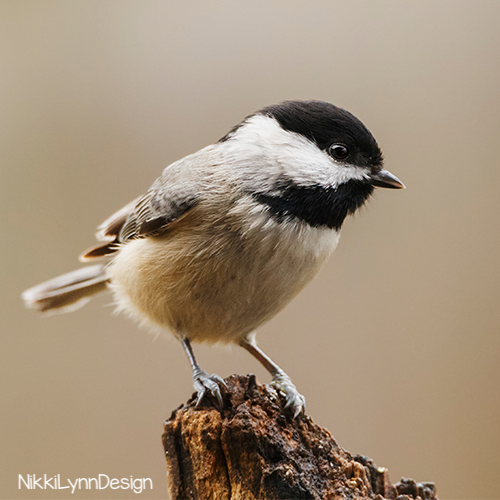
Black-capped Chickadee has a black cap and neckline with white sides to the face. Its undersides are white with rusty brown on the flanks. Its back is gray and the tail is normally slate-gray.
Females and males look the same, with females being slightly small.
8.) Chipping Sparrow

The Chipping Sparrow is a small sparrow with a distinctive russet cap when in the breeding season.
The bird has gray underparts and a gray rump. It also has a dark eye-line, a white eyebrow, a brown stripped back, and wings.
The winter plumages of Chipping Sparrows and American Tree Sparrows look very similar.
9.) Dark-eyed Junco

Dark-eyed Junco adults generally have gray heads, necks, and breasts, gray or brown backs and wings, and a white belly, but show a confusing amount of variation in plumage. The bill usually varies from a pale pink to yellow.
Read More about Dark-eyed Juncos.
10.) Pine Siskin

Pine Siskin adults are brown on the upperparts and pale on the underparts, with heavy streaking throughout.
The birds have yellow patches on their wings and tails, which may also consist of white streaks on the wings
11.) Purple Finch

Adult males are raspberry red on the head, breast, back and rump; their back is streaked.
Adult females have light brown upperparts and white underparts with dark brown streaks throughout; they have a white line on the face above the eye.
Purple finches are seed loving birds. Another favorite of finches are safflower seeds —> grow your own safflower seeds, easily learn how.
12.) Song Sparrow

Song Sparrows have brown upperparts with dark streaks on the back and are white underneath with dark streaking and a dark brown spot in the middle of the breast.
They have a brown cap and a long brown rounded tail. Their face is gray with a brown streak through each eye.
13.) House Sparrow

The house sparrow is strongly associated with human habitations and can live in urban or rural settings. Though found in widely varied habitats and climates, it typically avoids extensive woodlands, grasslands, and deserts away from human development.
It feeds mostly on the seeds of grains and weeds, but it is an opportunistic eater and commonly eats insects and many other foods.
14.) House Finch
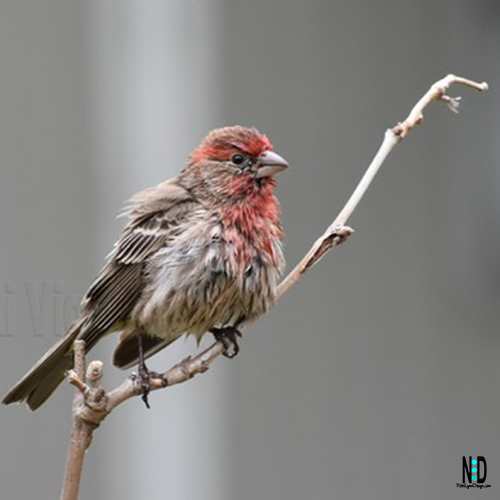
The house finch is a small passerine bird that is part of the family Fringillidae.
They are generally seen hanging onto the food source their eating from, perched, or scavenging the ground for food.
Read more about the house finch.
15.) American Goldfinch

The American Goldfinch is a beautiful songbird that you can easily attract to your backyard.
The males have bright yellow coats with a bold black cap and black wings barred with white.
The female is less striking with olive-yellow feathers.
Read more about the American Goldfinch.
16.) Mourning Dove
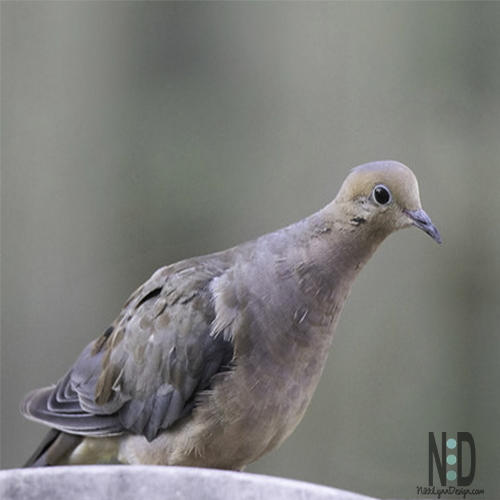
Mourning Doves are one of the most abundant and widespread of all North American birds.
The birds are light grey and brown and generally muted in color. Males and females are similar in appearance. The birds will eat seeds dropped on the ground from other birds.
Sharing Is Caring – Pin Me

If you are looking for a waste-free, no mess seed for small songbirds, I think you should try and add Nyjer seed to your feeders.
Additional Posts











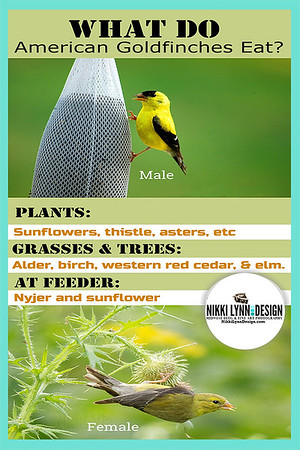
Feeders & Seed
Products That Carry Bird Images
AFFILIATE POLICY: Posts on this site may contain links to outside vendors that pay me a commission when you purchase from them, at no additional cost to you. Thank you for supporting this site!








